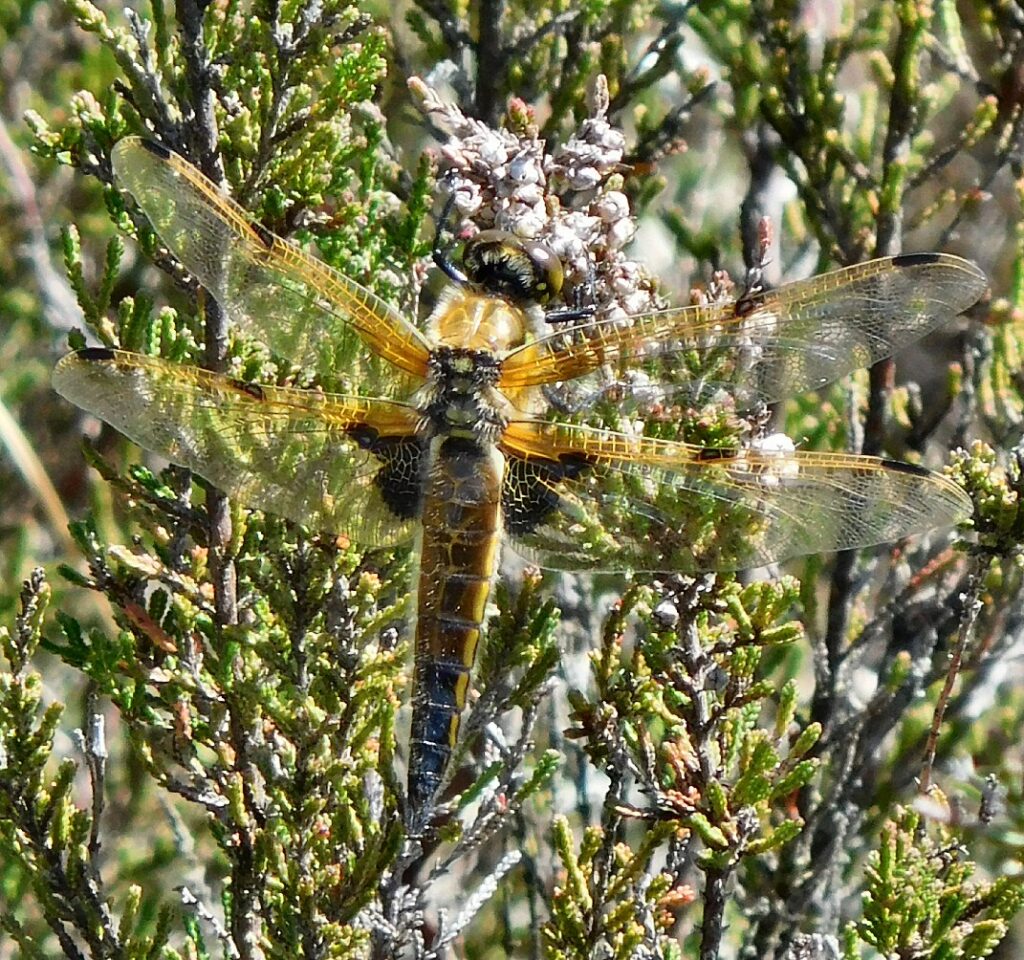
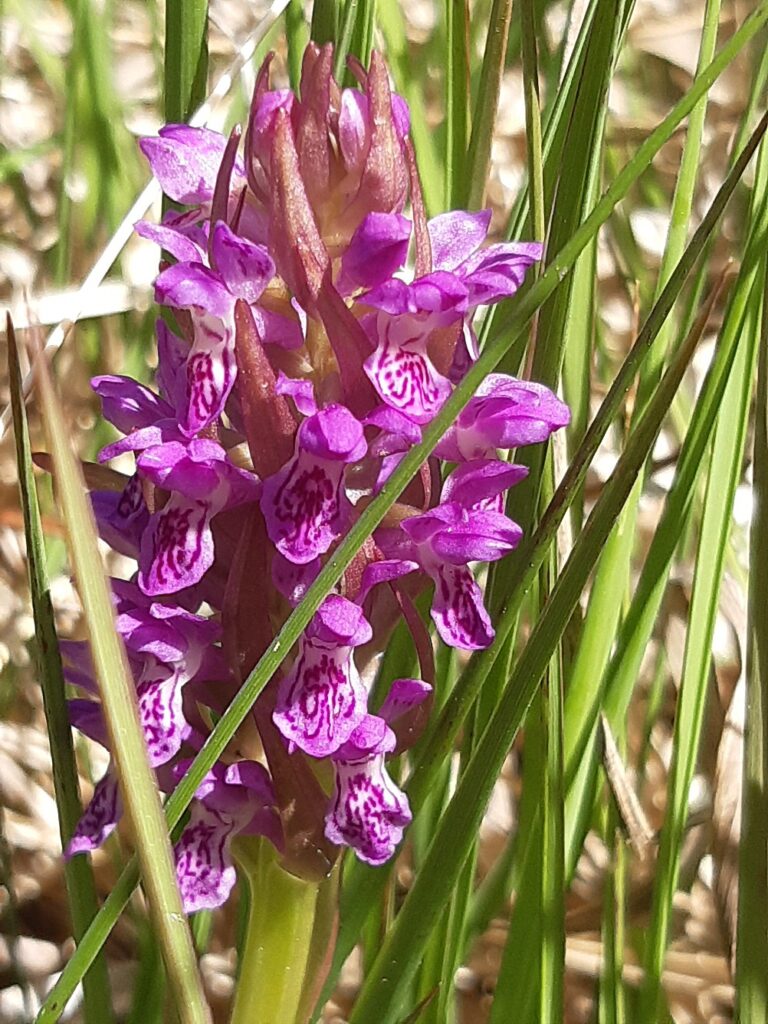
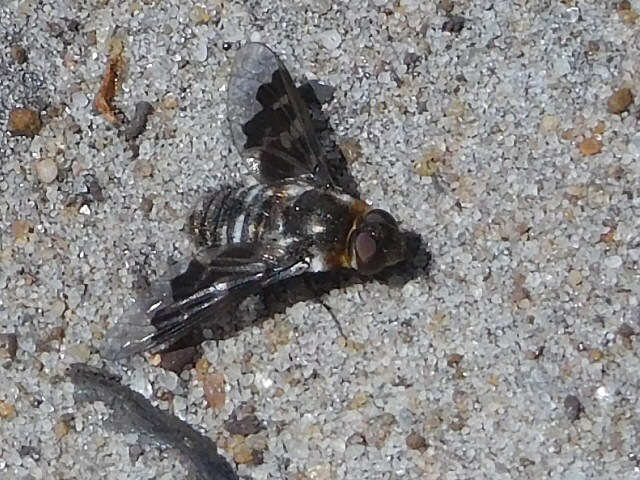
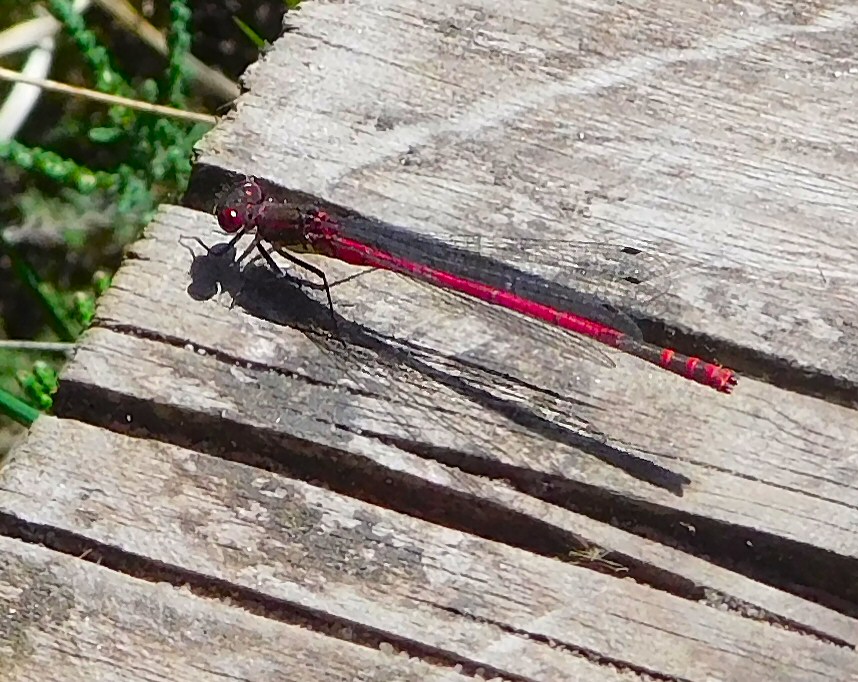
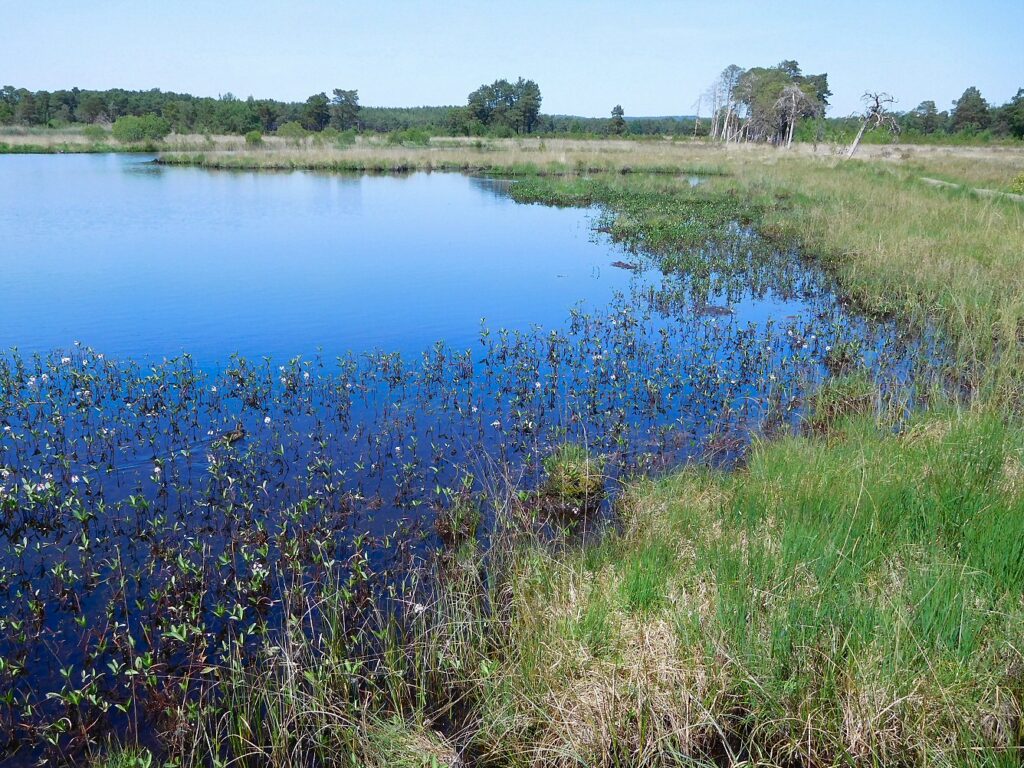

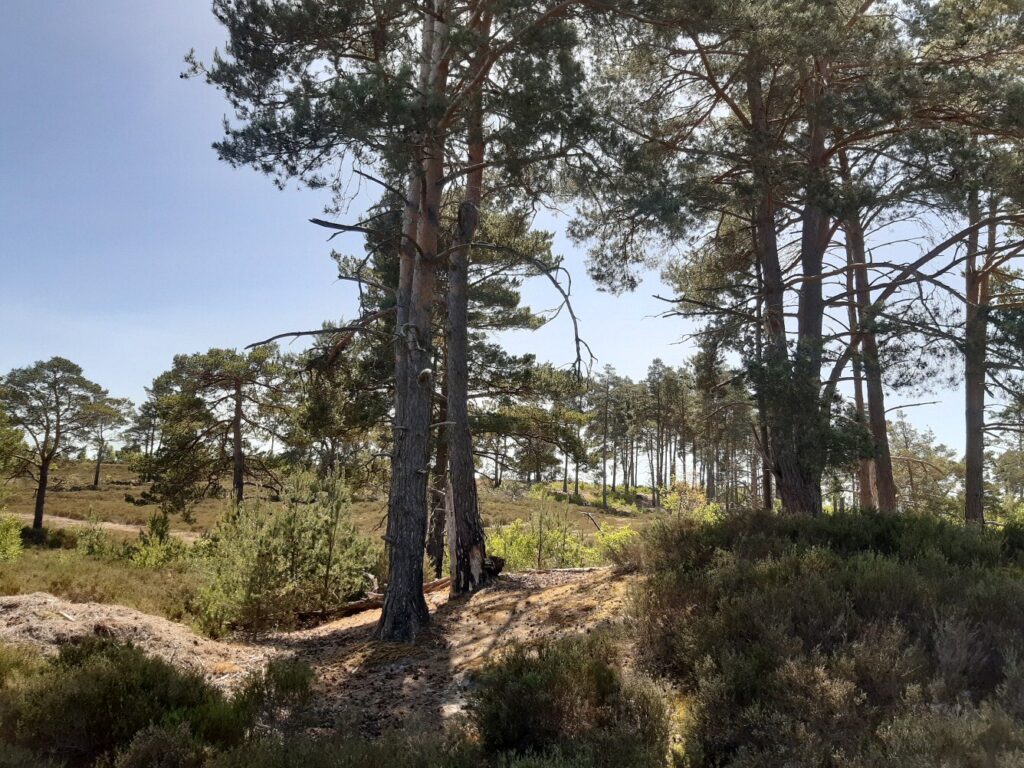







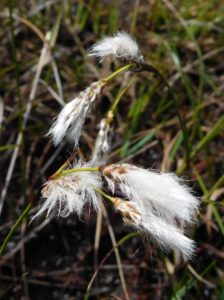
A bright, breezy, and much cooler day (16 C, not 29 any more) was just perfect for a visit to Thursley. Perhaps many of the dragonflies decided not to fly: I saw one Common Darter and (I think) one Brown Hawker, and nothing else, so anyone who went along hoping to see the Hobbies hawking for dragonflies by the dozen will have had a wasted trip (and indeed I saw several extravagantly camouflaged types with gigantic telescopes standing about looking very bored).
But everything else was in full swing. A Cuckoo called from the pinewoods. A Curlew gave its marvellously wild, bubbling call from the open marsh. A Dartford Warbler gave me the best view ever of its rufous belly and long tail, as it sat low in a scrubby Birch, giving its rasping anxiety call repeatedly. I enjoyed the view through binoculars. By the time I remembered to take a photo it was half-hidden again.
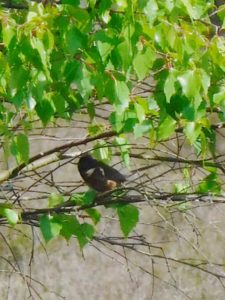
A Stonechat gave its scratchy call from a small Birch, then hopped up to some Pine trees (so, a distant shot).
A few Chiffchaffs called from the woods; plenty of Whitethroats sang from the regenerating Birches that are encroaching on to the heath. A Green Woodpecker gave its fine laughing call.
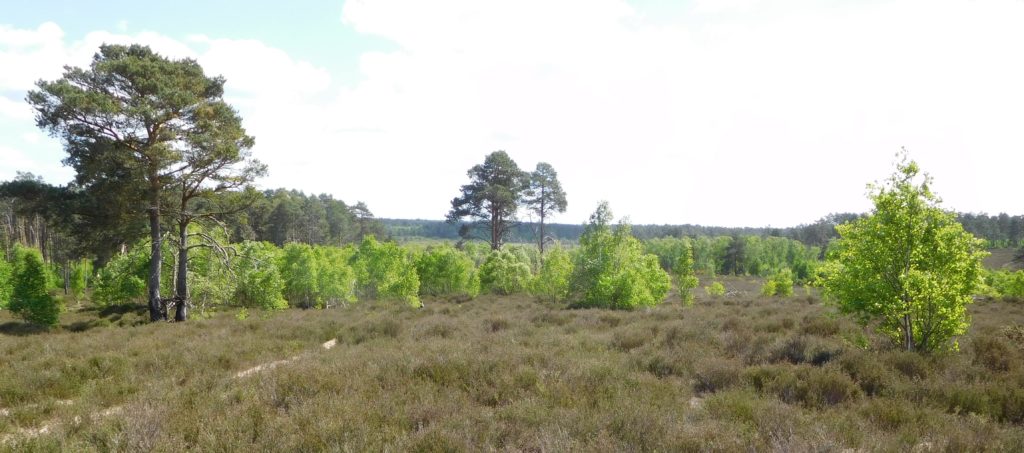
So I heard three warblers today to add to the four yesterday, so seven singing warblers in 24 hours, a little bit special.
The lichen flora on the heath was quite beautiful, with Usnea beard lichen, leafy Parmelia, bristly Ramalina (all on old Heather), and elegant Cladonia potscourer, cup, and stalk lichens (three species).
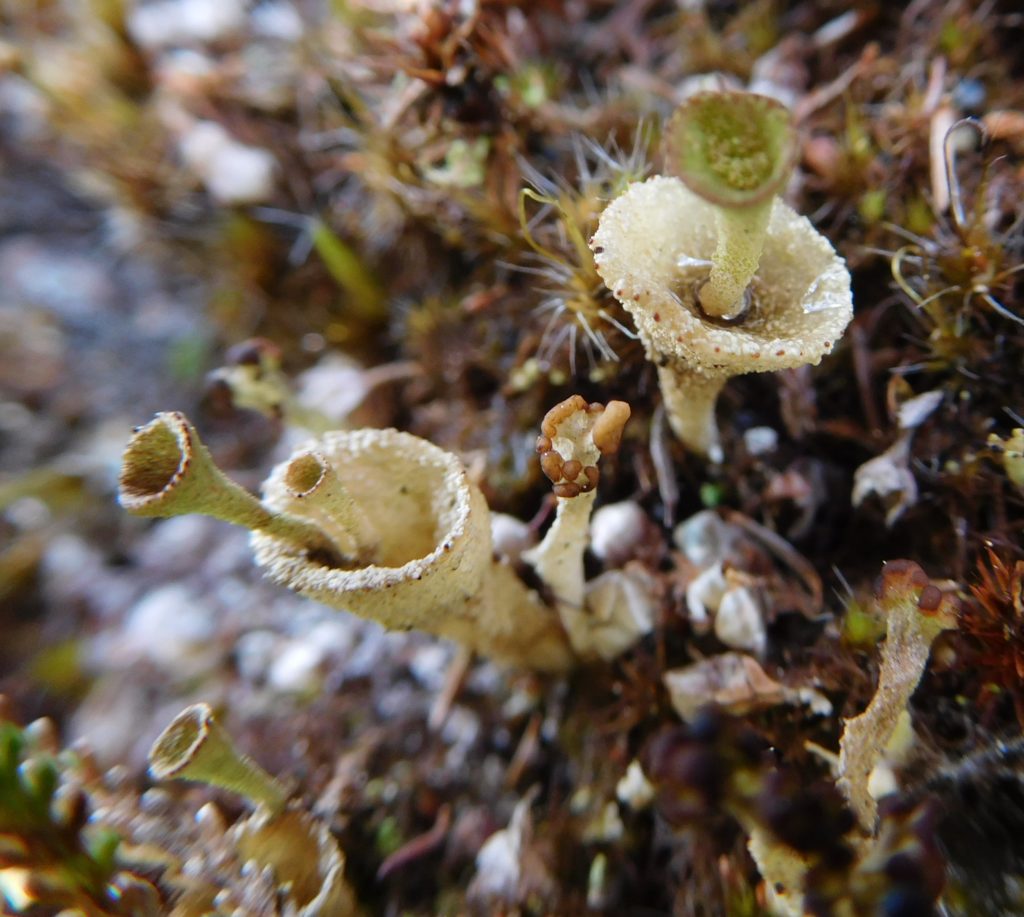
A Linnet sang from the top of a Birch. Goldfinches twittered and flitted about.
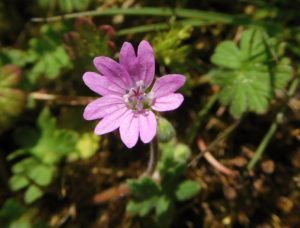
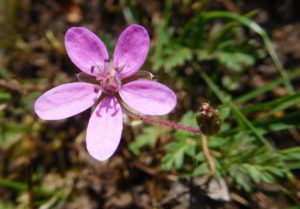
And on the path out, a Hobby leapt from a tree right in front of me, where it had been sitting watching the bog pools, waiting for dragonflies to come out and display themselves. It flew round and up, then circled, soaring, away to the south. Perhaps it was the one the twitchers had been waiting to see flying all morning.
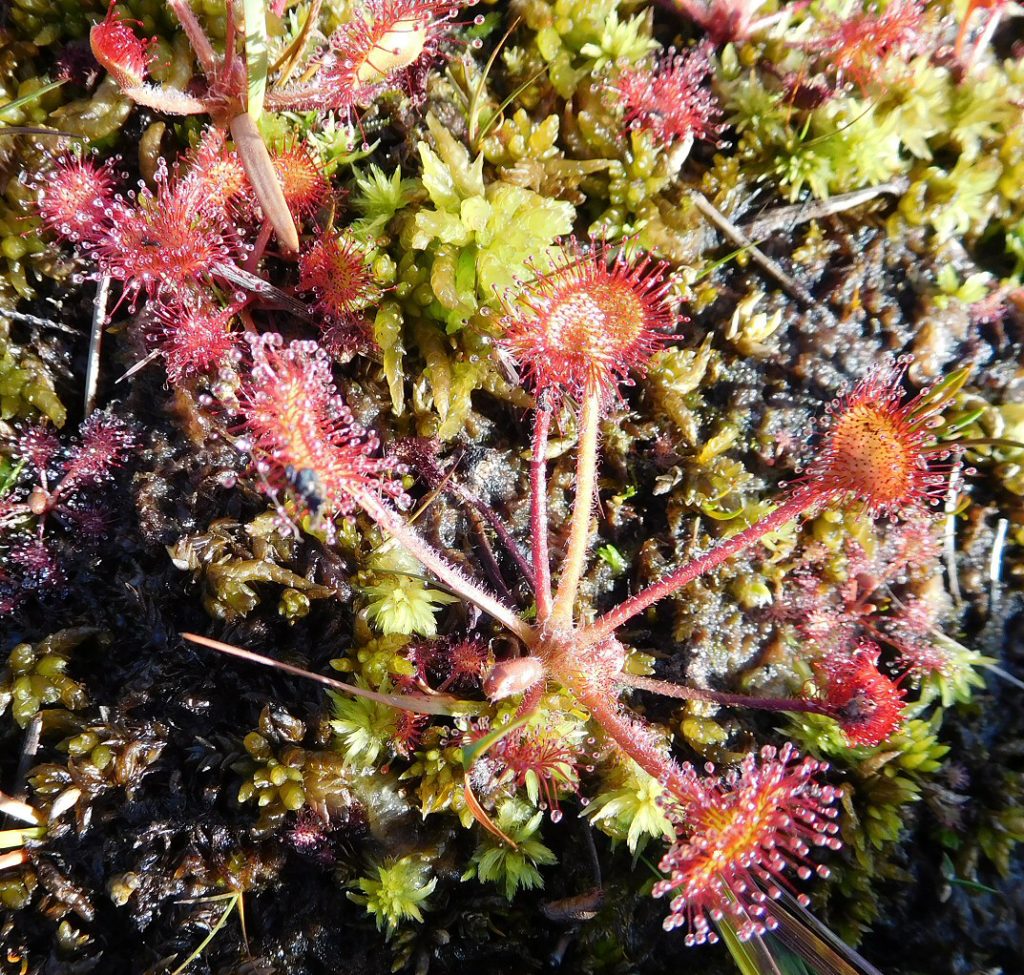
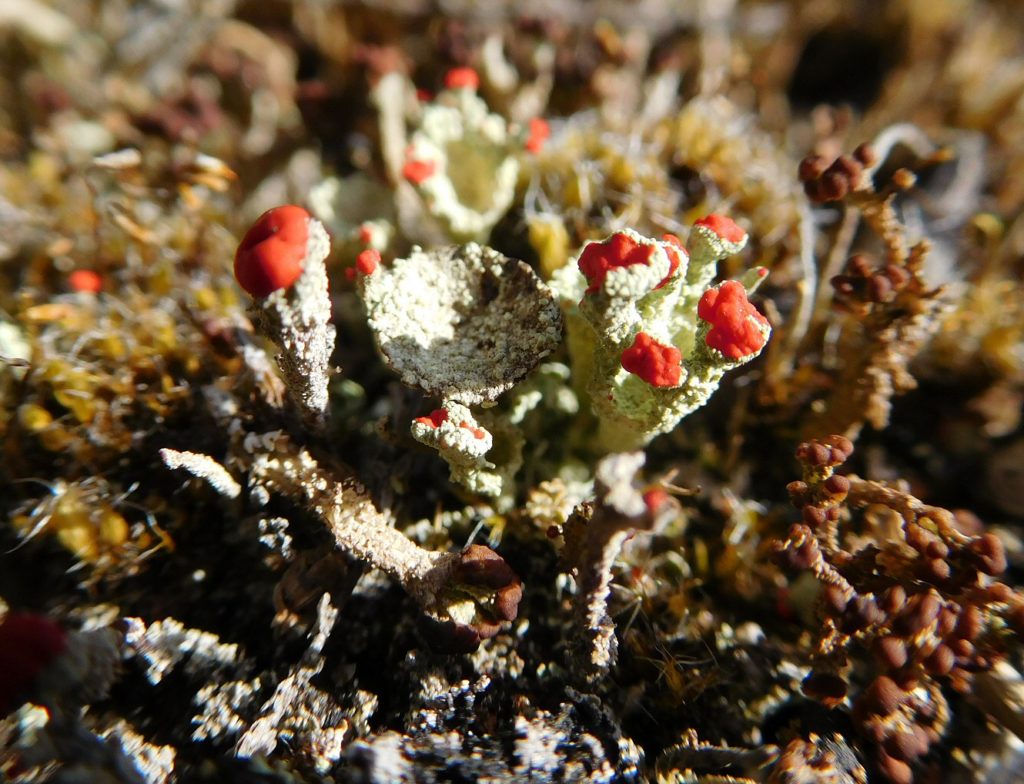
OK, ok, you wanted some dragonflies. There were masses of Black-Tailed Skimmers chasing about in groups at Pudmore Pond. Black Darters, Common Blue Damselflies, and Small Red Damselflies skittered about the smaller ponds. A large Hawker or two dashed past, unidentifiable, probably Southern Hawker. A Keeled Skimmer perched conveniently nearby, daintier than the Black-Tailed.
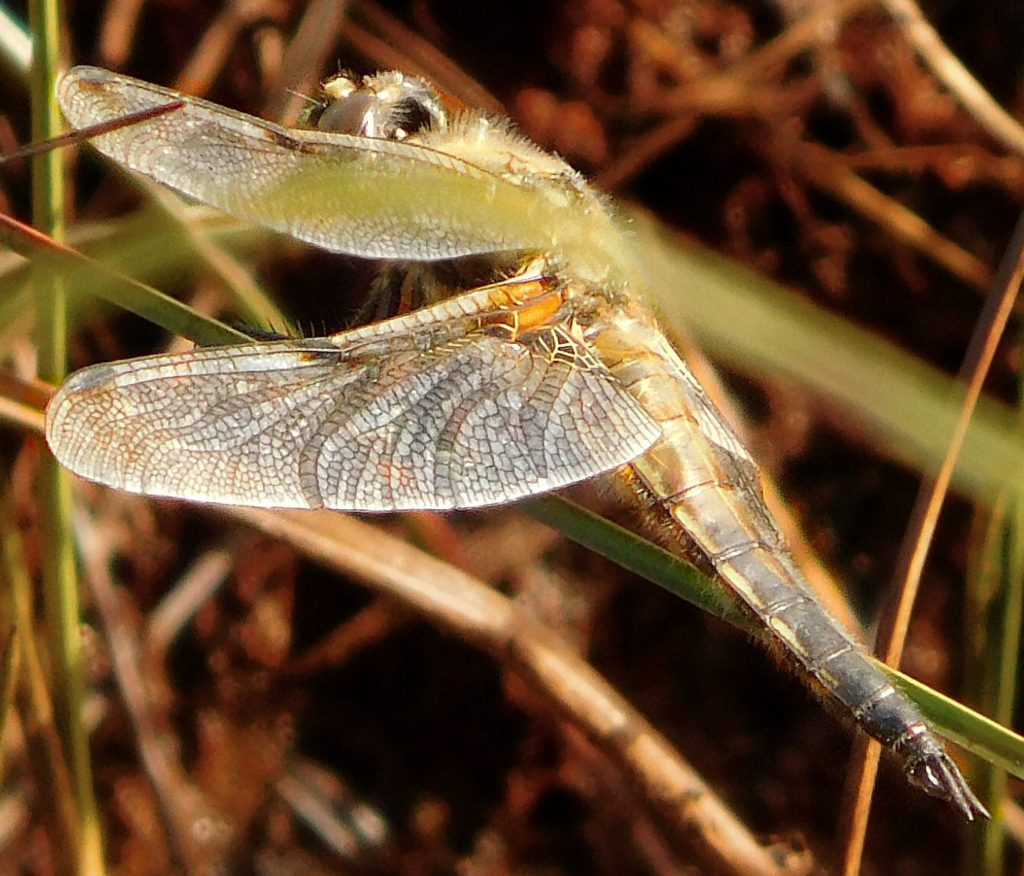
Among the birds, some 50 Swallows were roosting on telegraph wires early in the day. Families of young Stonechats gave grating contact calls, unlike the stone-clicking call of the adults. A Redstart flicked its tail in the bushes. Skylarks rose and sang almost too high to see against the clouds over the heathy hills, Shelley described it perfectly in his ‘To a Skylark’: “a flood of rapture so divine”.
It was a cloudless morning, perfect for a walk around Thursley Common to look for dragonflies, other insects, birds, and bog flowers too.
The bog pools were surrounded by Marsh Orchids in lovely purple bloom.
A few lizards, one with a regrowing tail, sunned themselves on the boardwalks.
Masses of Black-Tailed Skimmers chased aggressively about the pools, along with a few blue damselflies and some Black Darters. Some Large Red Damselflies warmed up on the heather, well away from the pools.
A Curlew called (or is it sang?) its beautiful, melancholic mating cry, flying high, slowly, and holding out its wings in a distinctive curve: something like a small heron, but with its incredible long downcurved bill, and tail feathers spread showily. It’s a rare delight, not least because Thursley is the only place Curlews breed for many miles around.
Stonechats sang their brief grating song from conspicuous viewpoints all over the common, sometimes in little family groups.
A Tree Pipit gave a fine display of its song flight from a tall tree.
On a lake filled with Yellow Water-Lilies at the edge of the common, gigantic Carp lurked and splashed at the surface, and Downy Emeralds chased, seeming club-tailed.
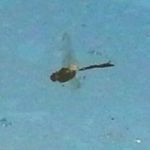
A Green Tiger Beetle whirred on to the path – a very strange flight jizz, but easily recognized once close enough.
Perhaps the most tantalizingly lovely insect of the day, however, was this Beautiful Demoiselle, shining iridescent Lapis Lazuli blue against the delicate pale green of a birch sprig.
The woods of Richmond Park were full of Jackdaws, constantly jostling for whatever position Jackdaws have in their noisy gangs. And the even noisier squawkings and screeches of the Ring-Necked Parakeets, of course, high in the trees or dashing about.
Out on the quieter grassland and bracken, now dry and brown, a Stonechat perched on a prominent lookout, its red breast, white collar and dark head distinctive.
A Kestrel drifted past, tail fanned, its handsome rufous back and dark wingtips characteristic; it turned and powered the other way, flew all across the open space over the anthilly grassland, and rose into a distant tree.
The upper Pen Pond had at least 6 Mandarin Ducks, the males ridiculously decorative, dressed like dandies and constantly showing off, alongside a few Pochard.
The lower Pen Pond had perhaps 30 Gadwall, a dozen Wigeon, a few Tufted Duck, and – best bird by far – a single Snipe that got up from the water’s edge near my feet, called ‘Creech’ once, and zigzagged rapidly off across the water, up and over the trees and the upper pond.
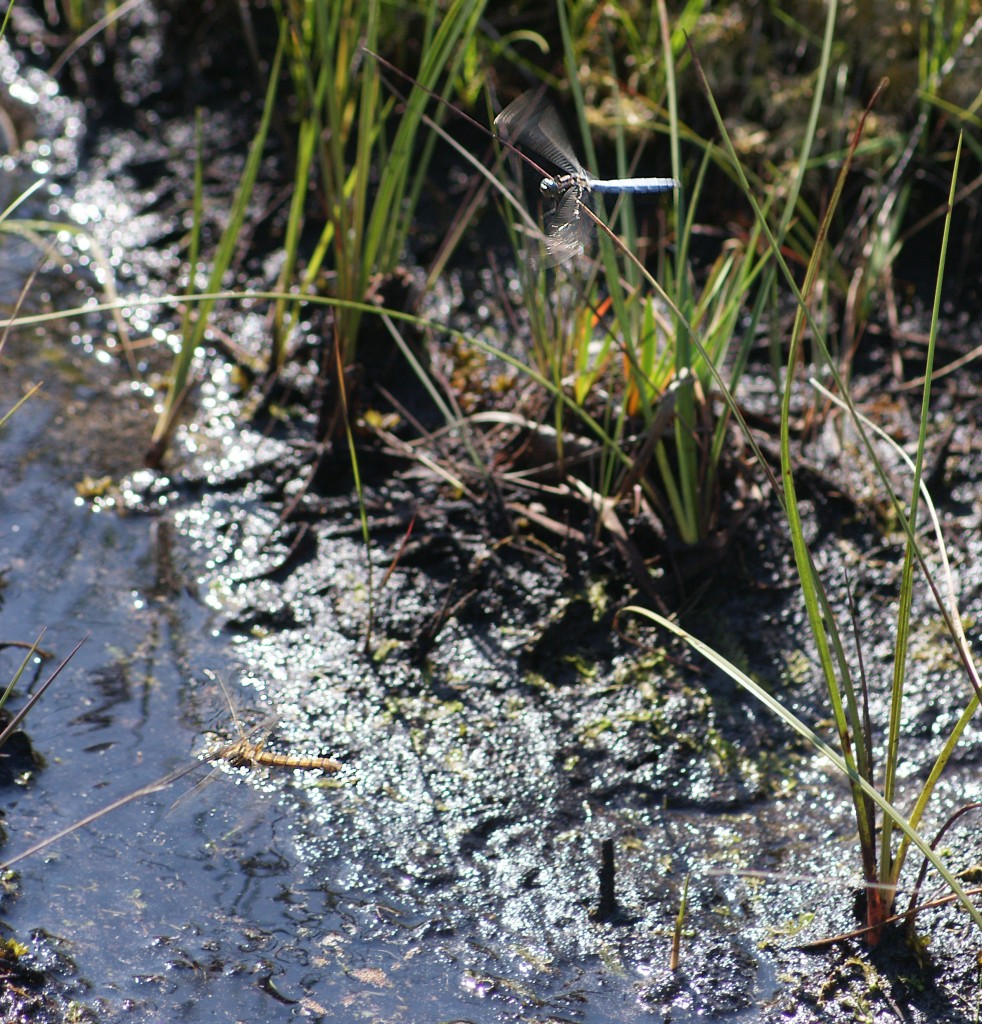
It was suddenly summer again this morning, so I packed cameras, binoculars and a sandwich and went down to Thursley in glittering sunshine. This photo perhaps catches something of the dazzle and sparkle of the bog pools and their shimmering guardians: a pair of Keeled Skimmers (Orthetrum coerulescens) are flying over the water; she is darting down to lay eggs, he is hovering above, guarding her from other males. Their wings sparkle and flash, and it is amazingly difficult to follow, frame, focus and shoot fast enough to get anything like a decent picture. But I rather like the motion blur in this one, and if it’s not perfectly in focus, you know why. I hope you like it too.
I was pleased, too, with this shot of an Emerald Damselfly, the sparkling water behind it forming a pattern of pleasantly out-of-focus circles.
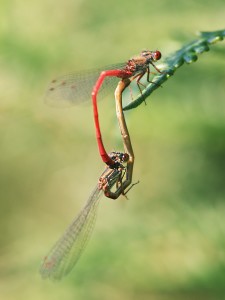
There were quite a few Small Red Damselflies about, mostly single but a few egg-laying pairs; and a modest number of blues, most likely Azures.
Apart from the hundreds of Keeled Skimmers, other dragonflies included Common Darter, Black Darter (I only saw a few females today), Black-Tailed Skimmer (just one), and Southern Hawker.
We saw few butterflies apart from Large Skippers which bustled about flowers near the boardwalk, and little Gatekeepers (I do mean they were smaller than usual) … until we arrived on the amazing Parish Meadow that was once a dump for emptying cesspits. Now it has an ecology strikingly unlike the rest of Thursley Common.
The meadow was full of Meadow Browns, Graylings (mating), Ringlets, Essex Skippers, a Brimstone, Large and Small Whites, and … a Purple Hairstreak (about the Oak trees). The rabbit-bitten pasture, dotted with little flower-stalks of Centaury, was thick with Ragwort, which in turn was richly covered with Cantharid beetles, solitary bees, wasps, and hoverflies and other Diptera. We put up a Silver Y moth which obligingly landed in front of us and perched in the open. We found the traces of a Green Woodpecker killed by a Sparrowhawk; but happily saw a live one in the Oaks nearby.
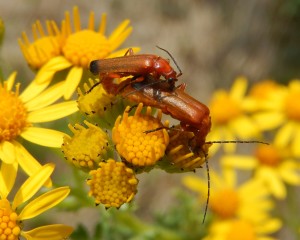
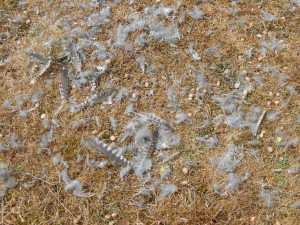
The boardwalks were busy with Lizards and Skimmers sunning themselves.
We met a local group of birders, complete with masses of tripods, telescopes and cameras, and asked if they were looking at the Stonechats. No, they replied, the Hobbies, there are three. We looked up, and sure enough there were three raptors. But in our binoculars, they turned out to be a Kestrel, a Hobby, and a Red Kite! Perhaps there were some more Hobbies somewhere else.
A little way further, absent the birders, we found a dead tree with some juvenile birds perched about it, and a lot of twittering. Yeah, a typical Chiswick Cafe. Some of them were young Redstarts; the others, young Stonechats: pretty confusing. But the Redstarts flew up into a Pine tree – not a Stonechatty thing to do – and sure enough, there was an adult Redstart on a lower branch, plain to see. And a Stonechat adult rasped out its grating call over to the right.
In a group of tall Oaks, we sat and ate a sandwich; and a Spotted Flycatcher flew across and perched on a high dead branch. It spent five minutes looking about, twisting its neck remarkably, but making no sallies. When I was a boy I saw them in the garden every summer; now they’re really something special, like, er, Starlings and House Sparrows.
The sandy heath paths were full of little holes dug by Ammophila Sand-Wasps, and others made by Philanthus Bee-Wolves (or Bee-Killer Wasps). Both are called digger wasps (“Sphecidae”) in most books, and it’s certainly a good name, but the family has been split up, so Philanthus is now in the Crabronidae, which contains most of the old “Sphecidae” (we’ll have to say sensu lato for this); the new Sphecidae (sensu stricto) only contains what used to be the Sphecinae, which includes Ammophila. Rich scope for confusion. Sphex is the ancient Greek word for wasp, and it’s interesting that Linnaeus chose this word for a digger wasp rather than the social wasps, which have the Latin name Vespa for the hornet, and Vespula, little wasp, for common wasps.
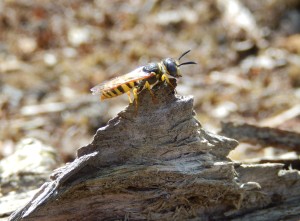
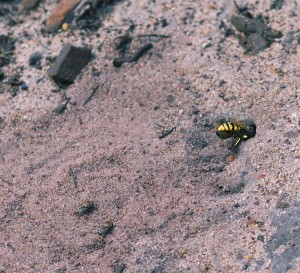
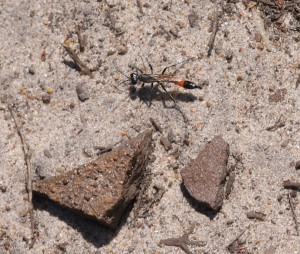
Out of a low bush of willow and gorse right beside a boardwalk came a strange, quiet but insistent squawky chatter of alarm. Peering in between the branches, a small slim dark bird with a long dark tail could be seen hopping about anxiously: a Dartford Warbler. It was extraordinary to be within a few feet of this shy, rare and retiring bird, and watching it for several minutes. There are actually quite a few on the heaths of Surrey and the south coast, but they’re never easy to see—most of my views have been of disappearing rear ends, diving into gorse bushes.

On a gloriously sunny, still winter’s day, Thursley Common looked wonderful. There were few signs of wildlife – a Crow or two, some Stonechats hawking for flies from the tops of small bushes – but wide horizons, quiet, a sense of space and freedom.

Some dead pines displayed magnificent natural patterns, the product of bare wood drilled by Longhorn Beetle larvae and exposed to the elements.
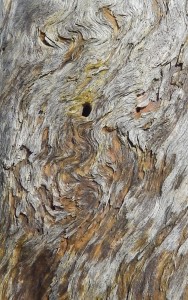
We visited Thursley’s thousand-year-old church – the north side of the choir has two small narrow Saxon windows, walled in for centuries. The church, of St Michael and All Angels, was wisely sited by the Saxons on a ridge of the Greensand, high and dry above the boggy moorland.
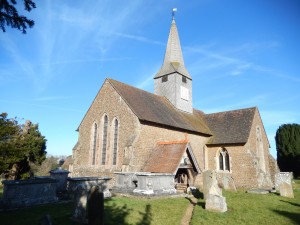
We enjoyed the modern glass doors engraved with a Tree of Life which turned out to be a Silver Birch. Among the animals praising God in the glasswork are a soaring, singing Woodlark; a perched Nightingale; a Lizard, a Purple Emperor butterfly, a Common Blue butterfly, and a selection of dragonflies: clearly the local fauna.
In Scotland, the male of the Red Deer is called simply a Stag, all other male deer (presumably Roe in that country) being known as Bucks. Down here, with Sika and other species about, it may be wise to name the species explicitly. There are signs up warning of the impending cull, so now may be the best time of year to see fine large stags resting quietly, the rut over.
I was welcomed to the park by a flock of Jackdaws chattering in the trees. Down in the valley, last year’s grass stalks are whitening, the fine big anthills well outlined in the low winter sunlight.
A Stonechat was perched on a slender stalk, level with the tops of the grass; there cannot be much in the way of insect food to catch just now.
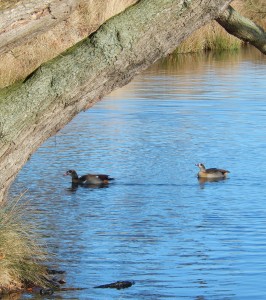
On the Pen Ponds, there were remarkably few waterfowl of any kind, but the lower pond had half-a-dozen Pochard. the males handsomely rufous-headed, a pair of Wigeon, the male with a conspicuous white wing-bar, and tucked in a corner under the willows a pair of Egyptian Geese, taking to the water and protesting with short dry honks when molested by a dog.
Walking back up the hill, a Kestrel hovered briefly, rested in a tree giving a good view of his spotted breast and back. Two herds of Red Deer, one at the base of the hill, one at the top, both with all ages and both sexes together, grazed silently. In the muddiest places, footprints of men, dogs and deer clustered together.
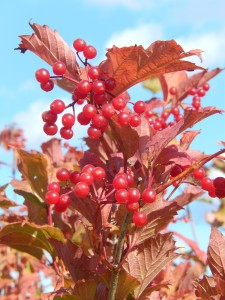
Today a brisk southwesterly wind blew the ragged clouds away, and it suddenly felt very much like autumn. The willows have lost many of their leaves, while other trees are still fully clad in green. Down at the Wetland Centre, the Guelder Roses were resplendent in scarlet: the photo is exactly as taken.
Down on the grazing marsh, a few migrant birds were giving the resident birdwatchers a treat. The Peacock Tower echoed to excited calls as a Whinchat perched on a faraway reed to the left, a Jack Snipe bobbed obligingly among some dead reeds to the front, and a Stonechat perched momentarily on a reed to the right. To my own surprise I saw all of them, even confirming that the Jack Snipe was bobbing up and down and had a dark stripe down the centre of its head. When it sat still it was marvellously hard to see, even in a telescope zoomed in and centred on the bird, its disruptive patterning doing an excellent job of breaking up its shape and matching the light and shadow of the vegetation around it.
Round on the wildside of the reserve, a few (Migrant) Hawker dragonflies and some Common Darters were still flying; and overhead, five House Martins, presumably on their way down south from somewhere far to the north, were busy refuelling on the many small insects flying over the water.
The riding stables swarmed with young Swallows, perhaps 15 of them growing strong for the flight down to Africa, twittering, swooping, perching on lofty cables.
On the hill, maize and sunflowers grew in glorious profusion, the bees drunk on nectar and coated with yellow pollen.
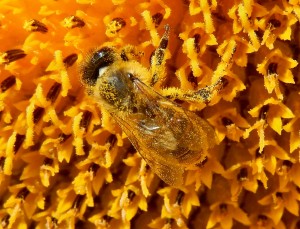
Along the chalk path, Common Blue butterflies skipped and perched on chicory flowers, delicate blue. In the bushy hedge, masses of darkly glossy plums blooming with pale blue yeast dangled from the trees. Above, a Stonechat rasped out his scraping call. I picked up two stones and made the exact same call by scratching them together, as if lighting a stony match: scritch, scratch. House Sparrows cheeped from the bushes; more anxiously, a yellowish leaf warbler, probably a Melodious Warbler, churred continually and flew about semi-conspicuously to perch repeatedly in the long grass to distract me from its nest – its young continually piping from deep in the hedge. I retreated gracefully.
A Turtle Dove cooed softly from high on a power line. At the stables, a Scarce Swallowtail (actually reasonably common here) drifted past; a White Wagtail hawked for flies beside the manège.
At 4pm the temperature reached 34.5 degrees: such a heatwave is called the Canicule or Dog Days, as Sirius, the Dog Star, is high in the midnight sky at this time of year.